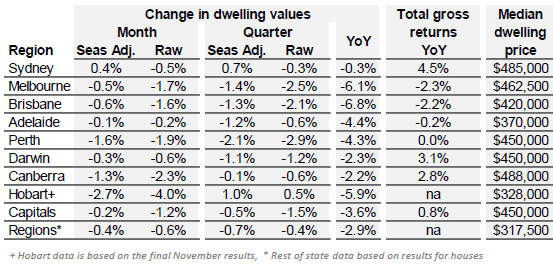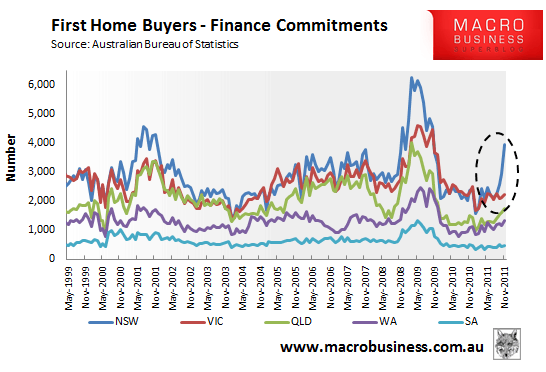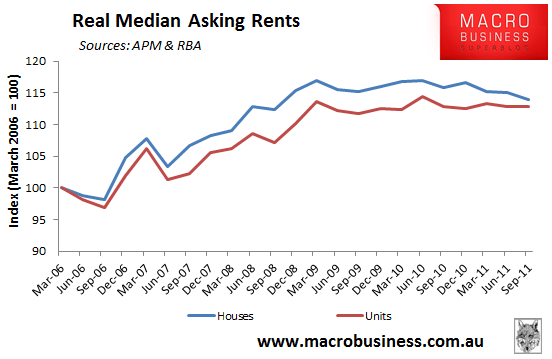
NAB’s quarterly survey of housing insiders shows an improvement in sentiment. And here’s why:
Moderating house price declines and stronger rental growth saw NAB’s Residential Property Index move just back into positive territory in the December quarter (+1 point) after two consecutive quarters of negative results. Although conditions improved in all states, there is considerable variation in state performance. Conditions are still weakest in Victoria (-22) and Queensland (-18) and strongest in NSW (+31) and WA (+18). Forward expectations have also strengthened since our last survey, with the index now forecast to record a bigger increase on the back of stronger house price and rental growth expectations.
Apparently price falls are moderating:
National house prices are still falling, but the pace of decline slowed to -2% (-2.4% in Q3). NSW (-0.3%) wasthe most resilient market while prices fell most in Queensland (-3.2%) and Victoria (-2.8%). House prices areexpected to fall by -0.4% over the next year (-1% in Q3). Modest growth is expected to resume in NSW (0.8%)and WA (0.1%), but the national average will be held down by continued price weakness in Victoria (-1.3%),SA/NT (-1.2%) and Queensland (-1%). National house prices are forecast to increase by 1.2% by December 2013 (0.5% previously). WA (3.2%) is expected to significantly out-perform, with house price growth forecast to be slowest in Victoria at 0.3% – although this represents a marked turnaround from -2.1% forecast in Q3.
And rental growth is accelerating:
Rental growth is accelerating and forward expectations have been revised up. Rents increased by 1.2% in theDecember quarter (0.7% in Q3), with rents improving in all states bar NSW. Rental growth was softest inVictoria (0.4%) and Queensland (0.4%), and strongest in WA (2.5%) and NSW (2.2%). Average rents areexpected to rise by 3.2% over the next year (2.5% in Q3). Rental expectations are strongest in NSW (4.5%)and WA (4.4%) and weakest in Victoria (1.8%) and Queensland (2.2%). Over the next two years, nationwiderents are tipped to rise by 4.6% (4% in Q3), led by WA (6.5%), SA/NT (6.5%) and NSW (5.6%).
And first home buyers are returning:
There was a notable increase in first home buyer activity in the new property market, likely reflecting a more benign interest rate outlook and softer house prices. Investors and overseas buyers were also more prominent in this market. Demand for new property remains strongest for inner city housing and low rise CBD apartments and townhouses. Resident owner occupiers continue to dominate the market for existing properties, but there was also a small increase in first home buyer activity in this market. Demand for all types of existing property strengthened slightly in all locations and the best prospects for capital growth continue to be identified in sub-$500,000 markets. Access to credit, interest rates and employment security continue to be seen as the biggest impediments to purchasing existing property, but slightly less problematic than in September.
The property industry upon which this survey is based is famous for its luck merchantry so let’s compare the survey results to what’s actually happening. Prices are falling everywhere but Sydney at much the same pace as they did last year:

It is “notable” how first home buyers remain very subdued despite two rate cuts. The exception is a fiscally engineered blowoff in NSW that will no doubt have payback in the next half and more than explains Sydney’s price out-performance:

Finally, rental growth across the nation is probably OK in spots but it ain’t tear away (at least up until September, we’ll get more today form the ABS:

Lipstick meet pig.

